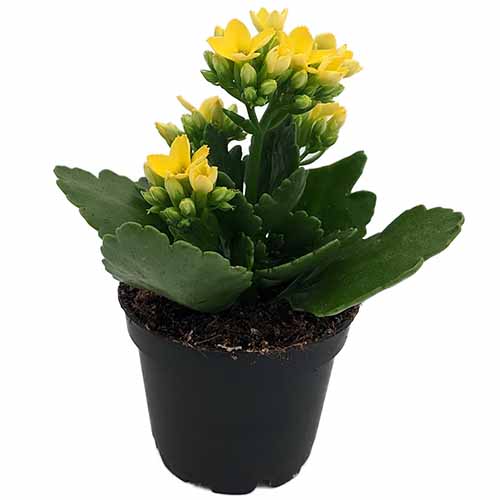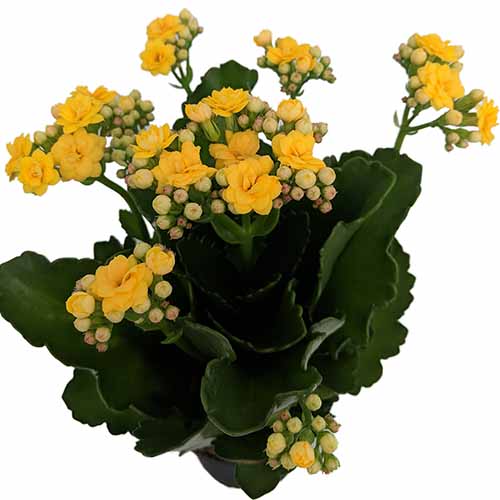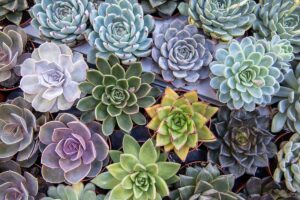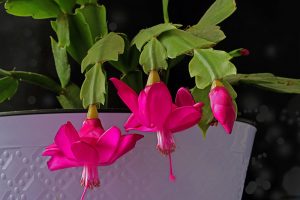Kalanchoe blossfeldiana
Flaming Katy, Kalanchoe blossfeldiana, is like a warm smile among succulents.
Also known as florist’s kalanchoe, Christmas kalanchoe, and widow’s-thrill, this cheery plant with its evergreen leaves also produces bright red, white, yellow, pink, or orange flowers – even indoors.
It’s long been a favorite in the season leading up to Christmas and it will bloom in the house for a full four to eight weeks during those drab winter days.
But you can also grow this variety outdoors year-round in USDA Hardiness Zones 10 to 12. Or, it’s possible to bring it outdoors to soak up some sun in the warm weather before bringing it back inside to overwinter in the house.
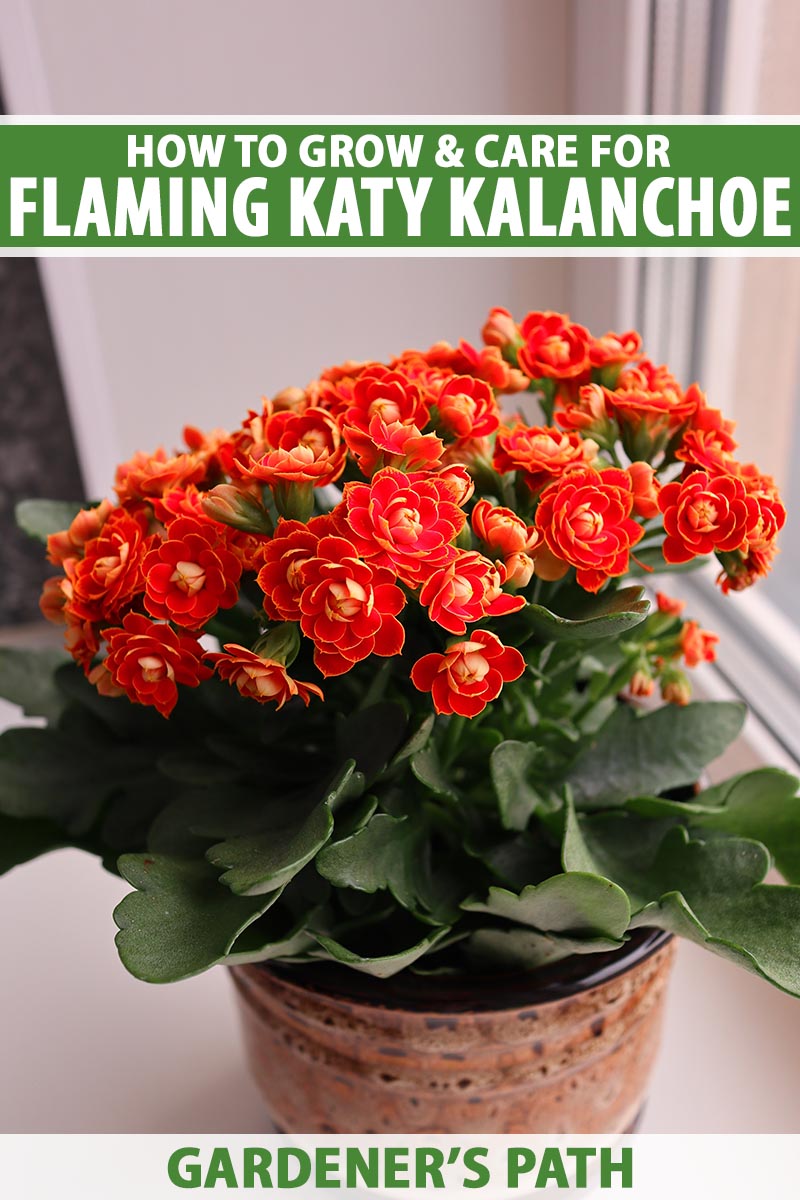
We link to vendors to help you find relevant products. If you buy from one of our links, we may earn a commission.
Dedicated gardeners can encourage this plant to rebloom beyond the first flush, maybe even for several years after it first blooms.
But even if you just opt to grow it as a green succulent after that first show of flowers, kalanchoe is a sweet day-brightener.
I first encountered it at my cousin Helen’s wedding reception, where she used small plants as part of the table decor at the beer hall known as Blob’s Park in Jessup, Maryland.
All of the guests got to take plants home with them. I enjoyed the blooms for weeks afterward, and kept that houseplant as a reminder of love for years.
Flaming Katy is an inexpensive, easy-care succulent that provides a lift in dreary times, whether you choose to give that gift to yourself or start cuttings to share with friends.
To learn more about this cheerful succulent, read on. Here’s everything we’ll cover:
What You’ll Learn
What Is Flaming Katy?
The botanical name K. blossfeldiana honors German plant breeder Robert Blossfield, who introduced this variety to Europe in 1932. But flaming Katy is native to Madagascar, and first described in 1926.
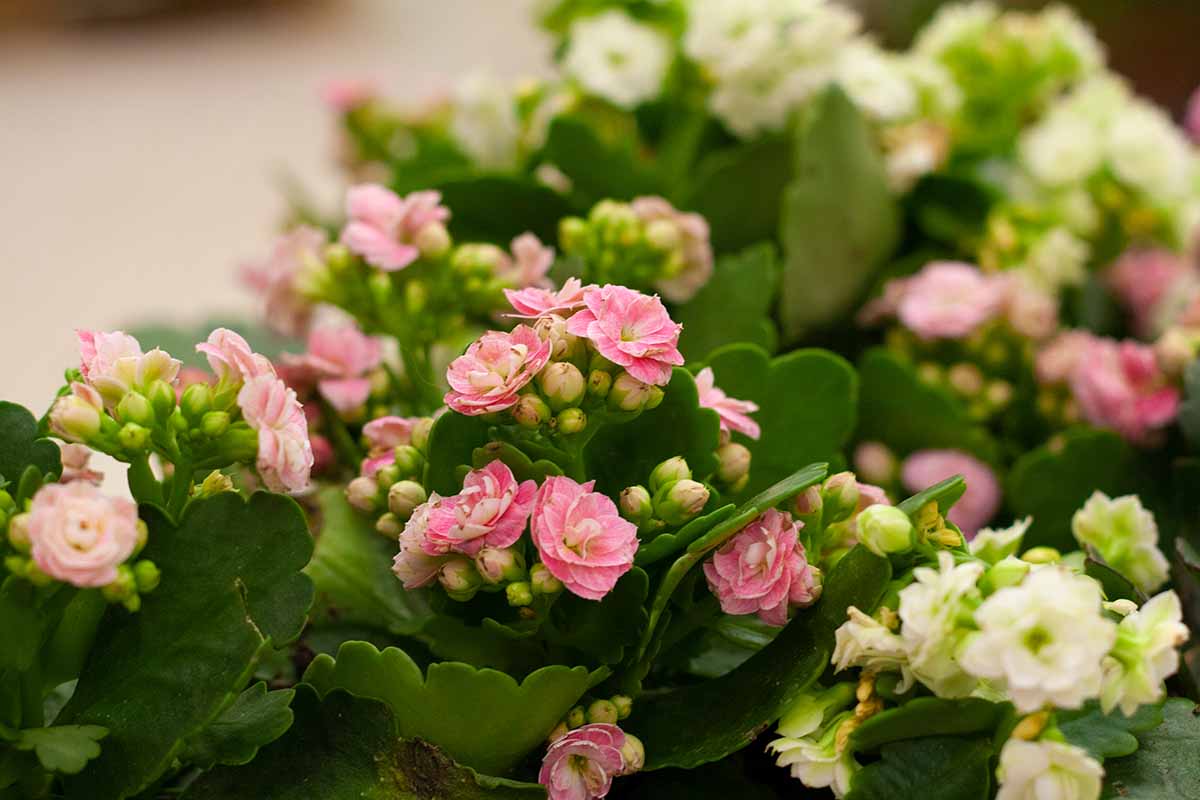
With its dark green, fleshy leaves with scalloped edges and clusters of bright flowers, it is the most popular houseplant among the 120 or so species in the Kalanchoe genus.
It takes two or three years to attain a maximum height of about 18 inches, though certain dwarf varieties only reach six inches tall.
Sometimes called widow’s-thrill, florist’s kalanchoe was once sold almost exclusively as a Christmas plant, and those early varieties only had red flowers.
Hybridization efforts made more bloom colors available starting in the 1960s and ‘70s, and 2002 ushered in the double blossom series Calandiva®. These sport blooms with up to 26 petals in a tight rosette instead of the typical four.
Even with all the advancements in breeding and the wider selection available, the fundamental traits of flaming Katy have persevered: It’s easy to care for and will put a smile on your face.
Want to grow some of your own? Let’s get started.
A Note of Caution:
The experts at the Missouri Poison Center say kalanchoe varieties like flaming Katy may cause nausea or vomiting if ingested. Do not consume any parts of this plant.
Pet owners should call their veterinarian immediately if a pet eats any part of the plant.
Propagation
Like all varieties of kalanchoe, flaming Katy may be propagated from either leaf or stem tip cuttings with high rates of success.
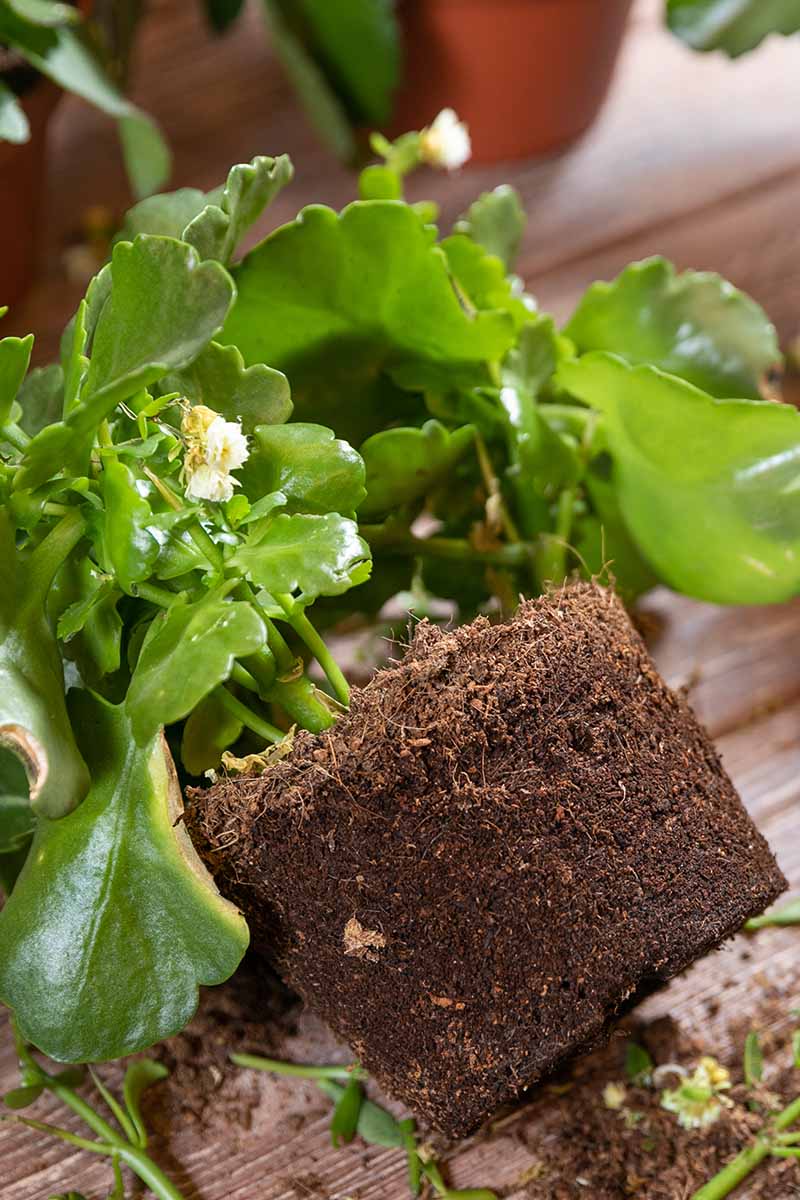
These plants are eager to grow! Nursery starts or those received as gifts may be transplanted into pots with drainage or into the ground as well.
From Cuttings
You’ll want to remove any flowers after taking a stem cutting, and then root it in premoistened succulent mix.
It takes a bit longer, and the outcome is less predictable, but you can also propagate florist’s kalanchoe from individual leaves.
It may also be possible to divide the plant when you repot, severing any offsets with a sharp knife and making sure to keep the roots intact.
You can find the step-by-step instructions in our guide to propagating succulents.
Transplanting
After you acquire established starts or purchase potted plants, it’s not too tough to transplant into a suitable container that’s more permanent, or into the ground.
First, bear in mind that flaming Katy is a carefree perennial only in Zones 10 to 12 if you plan to cultivate yours outside.
Once you meet that requirement, be sure to plant the starts in an area that will receive direct sun, whether they’re going straight into the ground or you’re using containers, and choose a pot or plot that allows the soil to drain quickly.
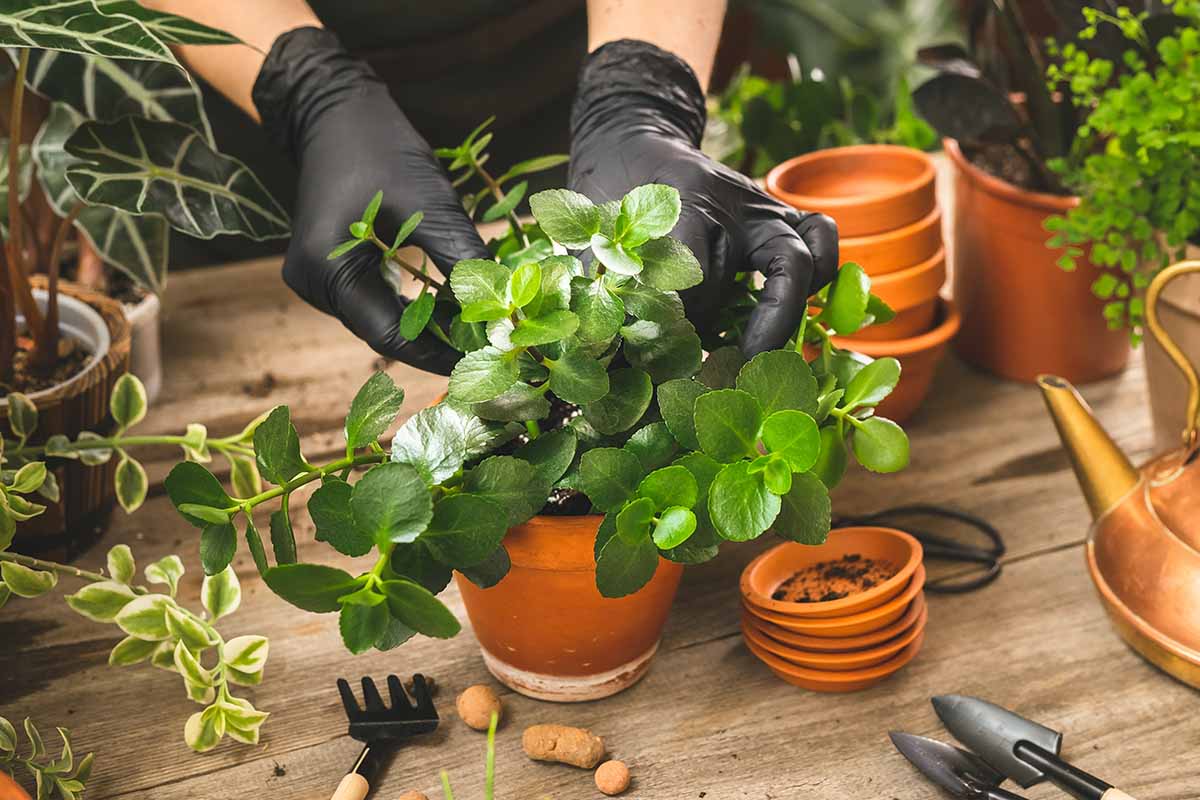
Also select a site protected from wind, since the fleshy, heavy leaves can be bowled over in strong gusts.
If you’re planting directly in a garden bed or border, center the plants eight to 12 inches apart for the best effect.
Cultivate the soil at least eight inches deep and dig holes that will allow the plants to sit at the same level they were in their original pots.
Gently tilt the transplants from their pots, loosen the roots if needed so they’ll point down, and place them in the holes.
Backfill with more well-draining soil before tamping the soil firmly with the heel of your palm. Be sure to water in the starts and stick around long enough to make sure the soil is well-draining.
To transplant into pots, select containers that allow the plants just a bit of extra room to grow. A pot with a diameter that’s a couple of inches wider than the root ball is good to begin with.
Only fill the container with succulent mix to within an inch of the rim so it won’t wash out when you water.
To learn more about choosing the right soil for houseplants, see our guide.
How to Grow
I’m confident that you’ll find it easy to keep florist’s kalanchoe alive, and these plants are excellent for beginners. Here are the basics:
Lots of light is kalanchoe’s top demand, but even that is negotiable. Outdoor specimens will do alright in part shade, but they may get a bit spindly or not bloom as much as their well-lit counterparts.

Lighting can get a little tricky indoors. Flaming Katy needs does best with six to eight hours of sun a day, so a sunny windowsill is ideal. But this tough plant can also thrive with ample indirect light, as long as it’s bright.
You may need to consider using grow lights for at least part of the day if you can’t provide enough natural light.
The other key to growing flaming Katy is to keep it from getting waterlogged.
Choose garden plots with soil that drains readily, preferably composed of sandy loam. Container-grown plants will benefit from a specialty succulent or cactus mix in pots with a drainage hole.

Indoors, you’ll want to make sure the soil is dry an inch down before offering these succulents a deep drink of water and discarding any extra that drains into the saucer.
Ordinarily, houseplants might require a drink once every two weeks. But use a soil moisture meter to make sure the succulent mix they’re growing in is slightly dry about an inch below the surface.
If you can grow flaming Katy outdoors, it will need supplemental water only when the soil is dry to a depth of an inch or two.
Soak the soil thoroughly and let the excess water drain from containers to discourage root rot.
Once a year, you may want to apply a balanced fertilizer to outdoor specimens to promote flowering and keep the plants healthy.
You can usually get away without it, but you might want to fertilize container-grown plants that are more than a year old once in spring and again in midsummer, during their prime growing period.
Use a liquid fertilizer formulated for succulents diluted to about half strength to amp up the growth rate.
Like most succulents, kalanchoes grow slowly. It can take two to five years for these to reach their mature height of six to 18 inches.
If you notice an older specimen is looking spindly, you may want to snip the stems to shape the plant. You can use your fingers to pinch off the tips of the stems at a spot right above a healthy, bushy set of leaves. Or, clip them off with clean scissors.
Note that if you’re planning to root the stem cuttings, you’ll want to lop them off directly below a leaf node, not above it. The node is where the stem will form roots.
Growing Tips
- Grow in full sun outdoors, or part shade in hotter climates.
- Indoors, they need direct sunlight or bright, indirect light for most of the day.
- Let the soil dry to a depth of 1 inch before you water.
- Let excess drain after watering containers, and discard any that collects in saucers.
Maintenance
The degree of difficulty when it comes to maintenance really depends on your intentions with a flaming Katy plant.
When you receive flaming Katy that’s already in bloom, even if you’re planning to compost it at the end of the blooming cycle, you will probably want to deadhead the spent flowers to keep it tidy.

For the plants you’ll keep growing as full-time houseplants or in containers that will move indoors for the winter, you’ll also want to deadhead the spent blooms and remove any damaged, shriveled, or discolored leaves.
This makes the plant more attractive, and also allows it to direct its efforts towards sustaining growth of more leaves.
If you plan to grow florist’s kalanchoe outside for just part of the year in cooler climates, keep an eye on the temperature.
They need nighttime temperatures of at least 60°F before being placed back outside in the spring after overwintering indoors, and they grow best at temperatures between 60 and 75°F.
Make sure to reintroduce the plants gradually after their “vacation” in the warm indoors, so they can get used to the increased natural light and lower temperatures.
Start with a couple of hours of outdoor time the first day, and add a couple of hours each day for the next few days until they can stay outside.
When the weather begins to cool, it’s time to move your flaming Katy indoors.
Kalanchoe grows best when it fits snugly in its pot. Still, you may need to repot once every year or two if you notice the roots are growing out of the drainage hole in the bottom.
You’ll also want to trade up to a bigger container when there’s no longer enough space in the pot for water to drain properly.
If you do move your flaming Katy to larger accommodations, only use a pot that’s a single size larger.
It may seem more cost-effective to move directly to a much larger container and then avoid that expense for several years, but that’s a false economy since kalanchoes grow better when they’re a little potbound.
Most of the maintenance for kalanchoe grown as perennials or as foliage-only container plants is straightforward and doesn’t take much time. The regimen becomes a bit more complicated, though, if you’d like to encourage your kalanchoe to rebloom indoors.
Outdoor perennials will only bloom naturally if you live in an area that periodically experiences a bout of short days, so not in locations like Honolulu, where the shortest day is still almost 11 hours long.
This succulent requires short days, about 10 hours long at the most, and a period of long, dark nights in winter – about 14 hours – to form blossoms.
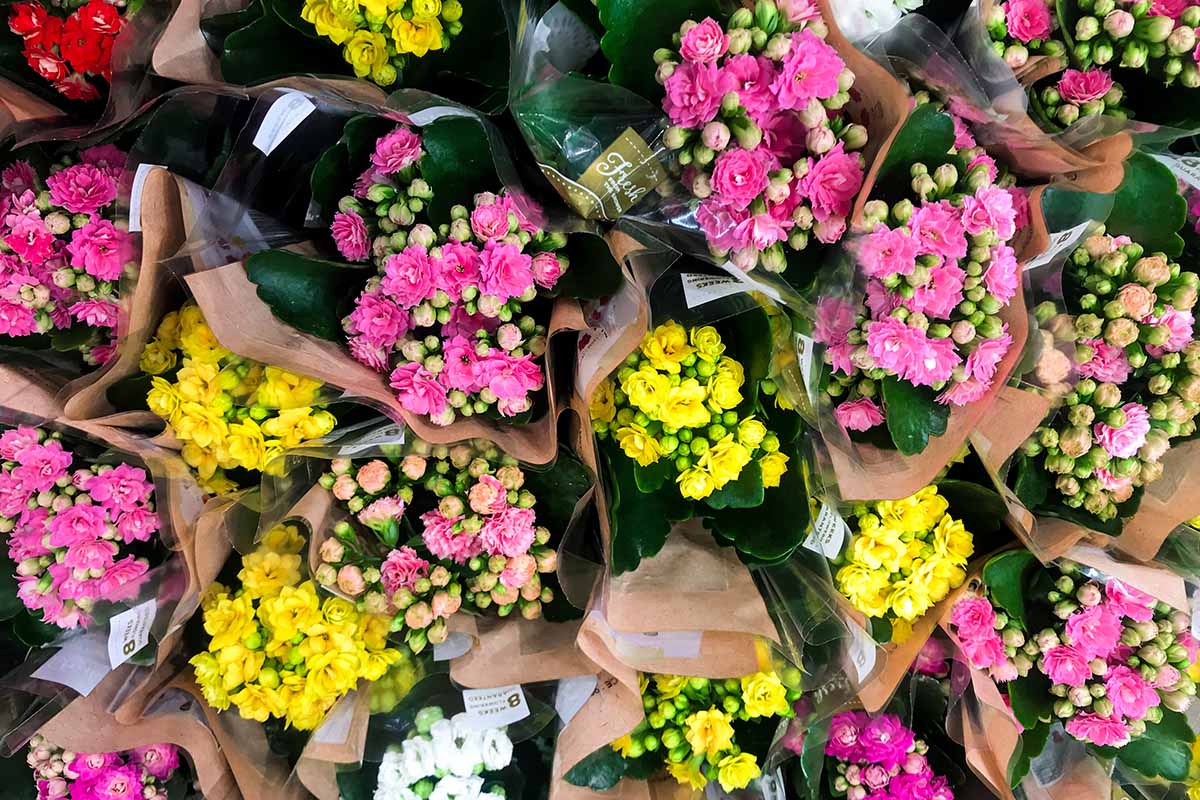
If you’re growing flaming Katy indoors, you may be able to force blooms. But the process requires initiative and patience.
Basically, you can use strong, artificial light on a timer set to give the plant 10 hours of light each day for about three months, and darkness the rest of the time.
When it forms buds, you can move it back into the outdoor sunshine or to a bright windowsill.
If you’re tenacious, you may be able to force these plants to bloom twice a year. Learn more about the process in our guide.
With a more easy-care approach, these plants can still be appreciated for their healthy, succulent foliage.
Where to Buy
The top considerations for choosing a suitable K. blossfeldiana are bloom color and style. Do you want elegant, white, four-petaled flowers? Or lavish double rosettes in pink?
You may also want to opt for smaller specimens if you’re going to be growing them as part of a dish garden or in a small space.
While there are numerous named cultivars available, some are simply labeled according to their color.
You may want to start with something like the yellow-flowering species variety sold in 2.5-inch containers from Hirt’s Gardens via Walmart.
They also sell a species plant of the same size with orange flowers. Find it here.
And a three-pack of K. blossfeldiana in assorted colors is available from Altman Plants via Home Depot.
The plants available may produce flowers that are yellow, white, red, coral, or orange.
One compact cultivar known as ‘Fuerball’ in German or ‘Fire Ball’ in English grows just six to eight inches tall at maturity, and has flaming red flowers and diminutive dark green leaves.
‘Nugget’ has orange blooms, and ‘Melodie’ is known for its pretty scalloped leaves, peach-colored blooms, and compact growth habit.
The fancier Calandiva® florist’s kalanchoe is striking and elegant, with double flowers that look almost like tiny roses growing on the evergreen succulent.
These grow slowly and reach about 18 inches tall. A variety of colorful cultivars are available, including orange, pink, purple, white, red, and bicolor white with pink.
Grandiva®, a subline of Calandiva® with large blooms, was introduced in 2012, followed by Calanday®, with single flowers and brighter colors.
Find Calandiva® plants with yellow flowers in 2.5-inch pots available from Hirt’s Gardens via Walmart.
Managing Pests and Disease
For the most part, flaming Katy is trouble-free. But you may encounter pests occasionally, particularly if you bring outdoor plants inside for the winter.
The most common pests to watch for are mealybugs, scale, and spider mites.
You can learn more about detecting, preventing, and eliminating these pests in our comprehensive guide to growing kalanchoe.
Regarding disease, the main way to prevent issues is to watch how you water.
If the soil becomes waterlogged or you let the plants sit in a saucer or plot of pooled water, they’ll quickly develop root rot, which is fatal. Protect outdoor potted plants from downpours, and ensure that the soil in garden beds drains quickly.
Powdery mildew can also be an issue. You’ll know your kalanchoe has this ailment if you spot spores on the leaves that look like a dusting of flour.
If your plant develops an advanced case, you may need to resort to fungicides. Our guide to home and commercial remedies for powdery mildew on houseplants will tell you what to do.
Best Uses
These were once commonly called “Christmas kalanchoe,” with good reason:
The blooms were always red, and the plants were sold in the weeks leading up to December 25 to be given as gifts and serve as decor that would cheer indoor gardeners and loved ones throughout the cold winter days following the holiday.
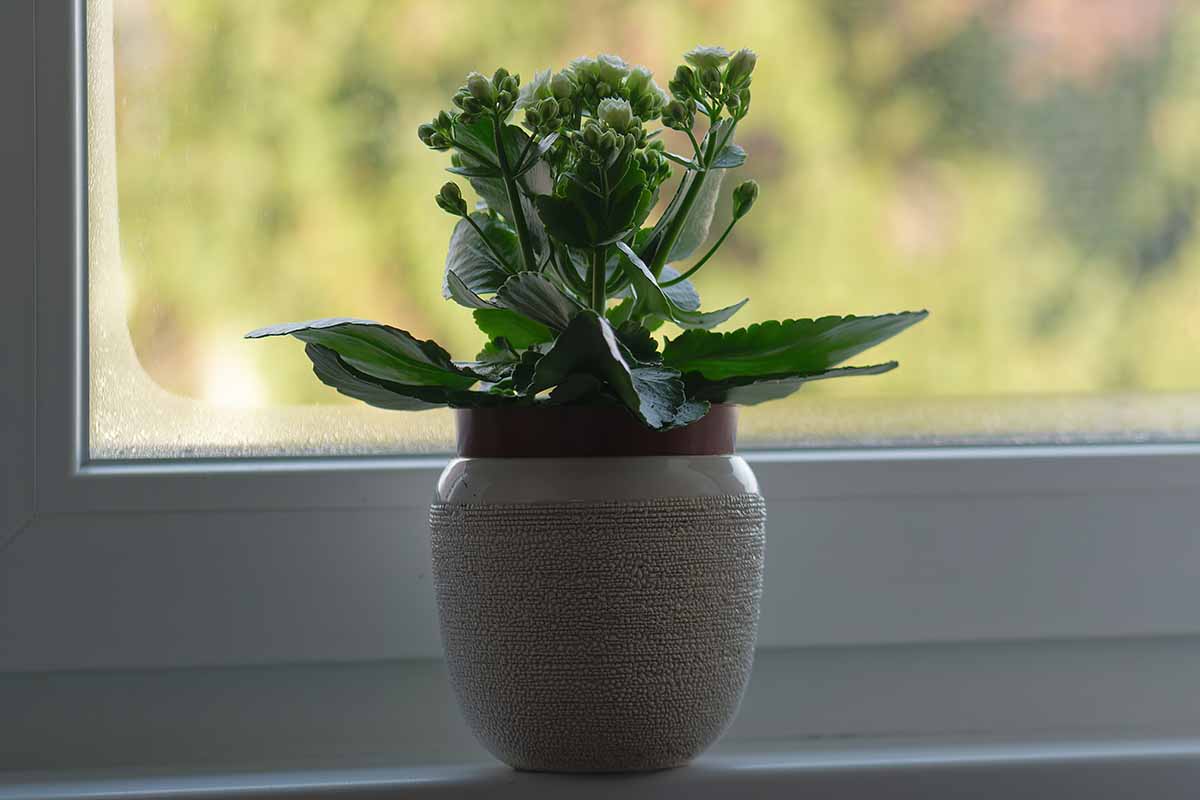
Even now that flaming Katy is available commercially in so many more colors and is sold year-round, I still think the best use of this succulent is as a wintertime day-brightener grown in a pot on a sunny windowsill.
These succulents are also lovely gracing a sunroom, or multiple plants can be grown in large containers or a series of smaller pots on a patio in warmer seasons, then brought indoors to overwinter.
Florist’s kalanchoes can also do double duty at bridal or baby showers, serving first as part of the table decorations or as centerpieces, and then going home with the attendees as party favors.
Whenever possible, the charm and color of these beauties should be shared!
Quick Reference Growing Guide
| Plant Type: | Flowering succulent | Flower / Foliage Color: | Orange, pink, purple, red, yellow, white/green |
| Native to: | Madagascar | Maintenance | Low |
| Hardiness (USDA Zone): | 10-12 | Tolerance: | Drought, poor soil, light shade |
| Bloom Time: | Winter through spring (outdoors); Late winter, early spring (houseplants) | Soil Type: | Sandy loam (in-ground); succulent or cacti growing mix (containers) |
| Exposure: | Full sun, part shade (outdoors); direct sun, bright, indirect light (indoors) | Soil pH: | 5.5-6.5 |
| Time to Maturity: | 2-5 years | Soil Drainage: | Well-draining |
| Spacing | 8-12 inches | Companion Planting: | Aloe, jade, and other succulents, asparagus fern, majesty palm |
| Planting Depth: | Crown at soil surface | Avoid Planting With: | Species with high water or low light needs |
| Height: | 6-18 inches | Uses: | Beds, borders, containers, houseplants, rock gardens, xeriscaping |
| Spread: | 6-18 inches | Order: | Saxifragales |
| Growth Rate: | Slow | Family: | Crassulaceae |
| Water Needs: | Low | Genus: | Kalanchoe |
| Common Pests and Diseases: | Mealybugs, scale, spider mites; leaf spot, powdery mildew, root rot | Species: | Blossfeldiana |
Flaming Katy: The Can-Bloom Kalanchoe
I enjoy the many options flaming Katy offers us plant lovers.
You can grow it outdoors full-time if you live in a region where that’s possible, or start the plants on a patio or an urban roof in the summer and move them indoors when cold weather looms.
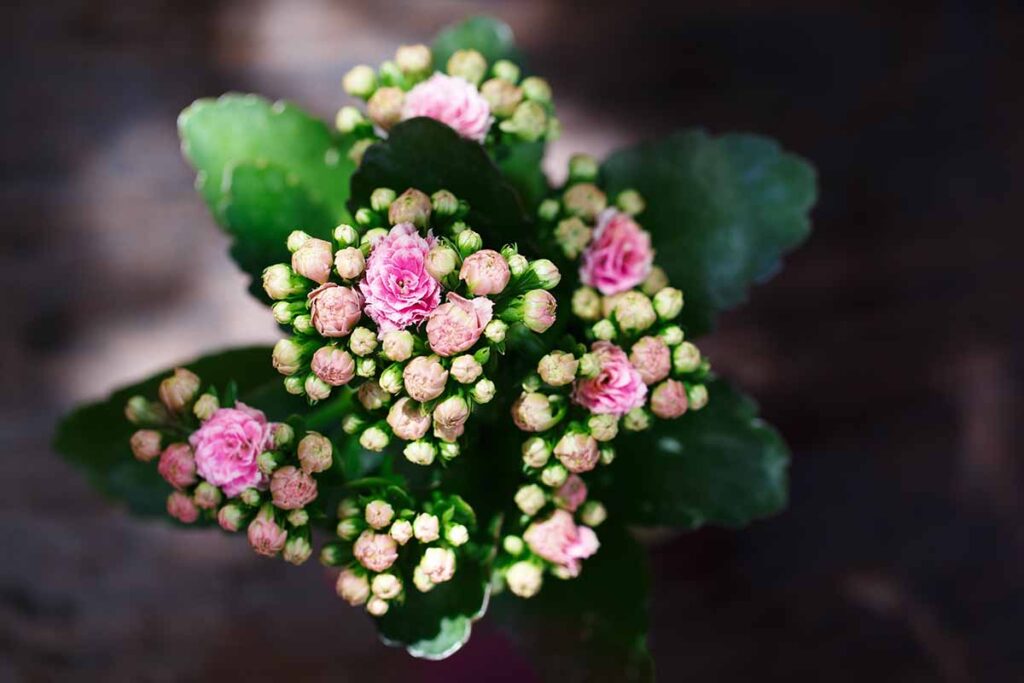
It’s also possible to enjoy the blooms for a single season as annuals if you just want to buy them at a nursery and then compost them after they finish blooming.
Or, you can continue to grow them just for the foliage or take steps to encourage them to rebloom.
Whatever level of involvement you’re willing to undertake, these succulents will be beautiful – for several weeks, a couple of seasons, or for five to seven years with proper care.
Have you grown this type of kalanchoe before? Share your experience or any questions that still linger in the comments section below.
And if you’re on the journey to find the best succulents you can grow at home, these guides can lead you in the right direction:

